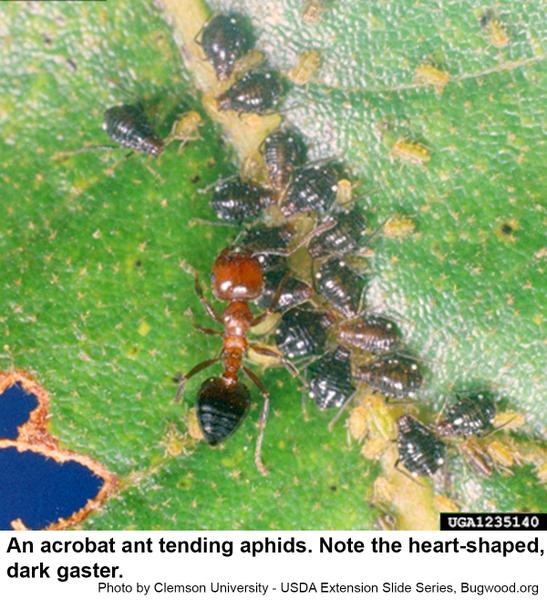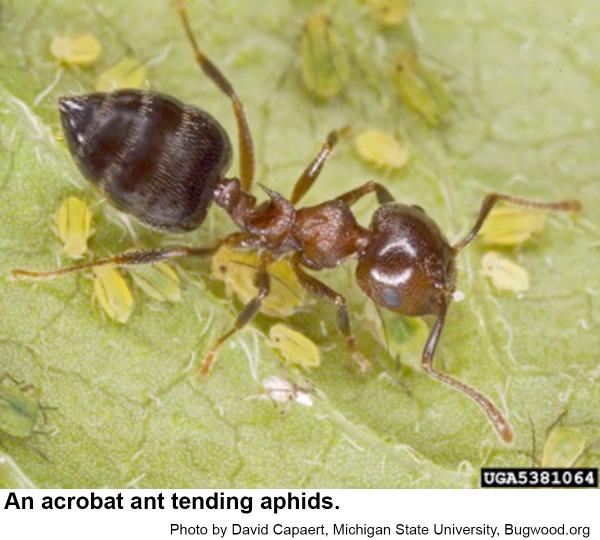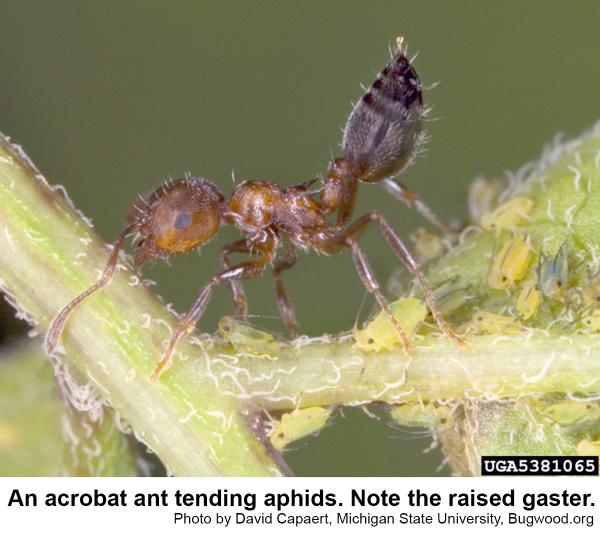Description and Biology
Some 420+ species of acrobat ants in the genus Crematogaster somewhat resemble fire ants in appearance but do not sting noticeably. The stinger is shaped like a spatula with which the ant wipes its venom on smaller, hapless prey. Acrobat ants carry the hind portion of the abdomen called the gaster above the rest of the body as if they were performing a balancing act. When excited, some species bend the gaster completely forward over the thorax so that they resemble tiny spiders. They are yellowish to dark brown and are just over 1/8 inch long. In top view, most of the abdomen is heart-shaped and it is usually darker than the rest of the body. These ants tend to nest in hollow stems and twigs and they may tunnel through soft wood much like carpenter ants. If the natural opening is large, acrobat ants make it narrower by constructing a cardboard-like wall. Sawdust may collect at the entrance of an active nest. Acrobat ants also construct loose, coarse-fibered cartons over scale insects. Acrobat ants use honeydew excreted by soft scale insects for food. Some acrobat ants also tend other insects that excrete honeydew (even butterfly caterpillars with glands that secrete a liquid the ants use). Acrobat ants lay down pheromone trails that allow fellow workers to navigate between food sources and the nest. Workers suspend the larvae on the walls of the nest with "anchoring hairs" that work like Velcro! The larvae are fed regurgitated honeydew. If there is no suitable hole to start a nest, acrobat ants build a cartoon nest on a branch or limb. When new reproductive ants are reared, usually in the fall, they often leave the nest much like termites do in a swarm that resembles a swarm of gnats. Evidently swarming is a mechanism that brings the male and female ants into close proximity.
Host Plants
Acrobat ants are not considered pests of trees and shrubs but they do protect scales and other insects that are pests. These ants tend to nest in hollow stems and twigs and they may tunnel through soft wood much like carpenter ants.
Residential Recommendations
Acrobat ants entering from outdoors can be managed by sealing the exterior cracks through which they enter, using a residual insecticide barrier along the foundation, or by treating the ant nest if the location can be determined. Insecticides containing pyrethroids are available at most big box stores labeled for landscape use. When used as directed, pyrethroids are very toxic to insects but are not particularly hazardous to humans and pets (other than fish-avoid using pyrethroids around pools, ponds, and streams). Always read and follow the directions on the label of whatever pesticide is used.
References
- Acrobat Ant. Iowa Insect Anonymous. 2006. Information Notes. Iowa State University Dept. Entomology.
- A Tibial Gland Scent-Trail and Trail-Laying Behavior in the Ant Crematogaster ashmeadi Mayr. Leuthold, R. H. 1968. Psyche 75:233-248.
- Encyclopedia of Insects. Resh, V. H. and R. T. Cardé. 2009. Academic Press. 1024 pages
- NC State Extension Plant Pathology Publications
- NC State Extension Horticultural Science Publications
- North Carolina Agricultural Chemicals Manual
For assistance with a specific problem, contact your local N.C. Cooperative Extension center.
This Factsheet has not been peer reviewed.
Publication date: March 31, 2016
Reviewed/Revised: Aug. 29, 2019
Recommendations for the use of agricultural chemicals are included in this publication as a convenience to the reader. The use of brand names and any mention or listing of commercial products or services in this publication does not imply endorsement by NC State University or N.C. A&T State University nor discrimination against similar products or services not mentioned. Individuals who use agricultural chemicals are responsible for ensuring that the intended use complies with current regulations and conforms to the product label. Be sure to obtain current information about usage regulations and examine a current product label before applying any chemical. For assistance, contact your local N.C. Cooperative Extension county center.
N.C. Cooperative Extension prohibits discrimination and harassment regardless of age, color, disability, family and marital status, gender identity, national origin, political beliefs, race, religion, sex (including pregnancy), sexual orientation and veteran status.



